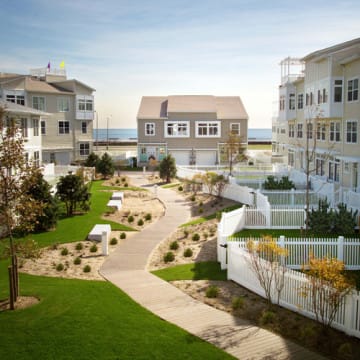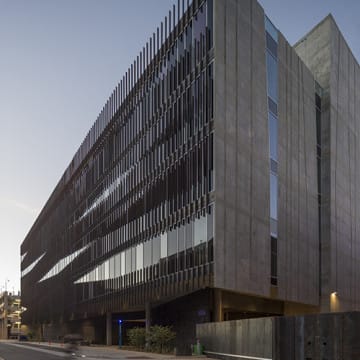The Residences at La Cantera
IN SAN ANTONIO, TEXAS, resilience means being able to prepare for, recover from, and adapt to drought. So when USAA Real Estate Company, San Antonio, and the Cambridge Development Group, Dallas, were planning a resort-style destination town center at La Cantera, a master-planned community on land owned by USAA, they committed to developing a project that conserved and recycled water. “Drought in San Antonio is a way of life, and addressing that within the building design made total sense to us,” says Hailey Ghalib, managing director of the USAA Realty Company and national director of its multifamily development program.
Completed in 2014, the $47 million Residences at La Cantera is a four-story, 425,697-square-foot multifamily building with 323 apartments and 3,700 square feet of retail space. Located next to the Shops at La Cantera and the La Cantera Hill Country Resort, the Residences include amenities such as a clubhouse, cyber café, fitness center, resort-style pool, and Jacuzzi. The 150-acre master- planned community is being developed with 1 million square feet of Class A offices, upscale shops, restaurants, and lifestyle amenities and will be connected by a pedestrian greenway, a network of urban parks and natural areas, and a hike and bike trail.
USAA Real Estate Company and the Cambridge Development Group sought to provide an attractive resort landscape while respecting the need to conserve water. San Antonio periodically has instituted water-use restrictions in response to drought. During La Cantera planning in 2011 and 2012, Texas experienced one of its worst droughts ever, which it recovered from only in 2015 with excessive rains that briefly helped restore water levels. Just months later, San Antonio had water restrictions back in place, limiting the use of irrigation systems and water features.
Mitigating Risks
USAA worked with Looney Ricks Kiss, an architecture firm based in Memphis, Tennessee; Austin- based landscape architect J. Robert Anderson; and Dallas-based Jordan Foster Construction. With this team, USAA focused on resilient design and construction strategies for the building, which meets Texas Green certification standards. The developers’ planning and design choices have had the most effect on water conservation. They installed Energy Star–certified dishwashers and high-performance kitchen faucets and shower heads and located water heaters close to fixtures in most units, thus reducing the amount of water wasted while the resident waits for hot water.
The developers also addressed drought through the design of the landscape and its focal point, a 1.5-acre park that features an urban plaza, great lawn, adventure playground, pond, and picnic areas shaded by preserved live oak trees. They installed native and other drought-tolerant plants and mulched landscape beds at least four inches deep to retain moisture from irrigation.
They constructed a 10,000-gallon cistern next to the wet pond to store rooftop stormwater runoff and condensate from air conditioning equipment, which are piped from the buildings; this recycled water is then used to irrigate the park and renew the pond. The developers have begun focusing more on resilience metrics. For example, the cistern, which was sized to hold enough water to irrigate the park daily, was retrofitted to monitor water levels and the amount of water being added daily. Thus, they know that watering requirements range from 1,000 gallons a day to 4,000 gallons a day. Because the cistern collects up to 4,500 gallons a day (when all the units are filled) and is constantly being refilled, the owners know they can meet irrigation needs.
Creating Value
Protecting the value of the amenities of the park and the plantings—even under drought conditions— was key to USAA’s decision making. “Part of the motivation was being a responsible corporate citizen and ensuring that the landscaping and public park would be irrigated with limited use of potable water,” says Ghalib. The park alone cost $1.4 million to build and would cost at least $425,000 to replace if damaged by drought.
The value of the park translates to rent premiums for park views of between $35 and $50 a month per apartment, or $25,560 of additional annual revenue, resulting in about $500,000 in added asset value. Resilience savings so far include lower maintenance costs and an immediate beneficial effect on operating income. As Ghalib says: “We saw the cost efficiencies in cutting back on the water bills and being able to maintain the park through drought conditions and water restrictions by capturing water that otherwise gets wasted.”
The landscaping for the park requires between 30,000 gallons of water a month in winter and 118,700 gallons of water a month during the summer—a total annual water requirement of 878,400 gallons. On the basis of San Antonio Water Service’s 2015 water rates, water charges would total approximately $3,840 annually. Additional fees, including a service availability fee and a stormwater fee, would add $5,000 a year to the water bill. The Residences consequently save an estimated $8,840 in annual water charges by using the air-conditioning condensate and stormwater collection system to irrigate the landscape. The water recycling system also has marketing advantages, says Ghalib. “Whenever we tell tenants, residents, and visitors about the water reclamation, people receive it really well. It is definitely a distinguishing feature.”
USAA’s resilience efforts for the Residences at La Cantera are part of a company commitment to “build every asset as if we are going to own it long term,” says Ghalib. “With this one, we’re making sure every decision about materials and equipment makes sense for us and anyone else.”
“Drought in San Antonio is a way of life, and addressing that within the building design made total sense to us.”—Hailey Ghalib


